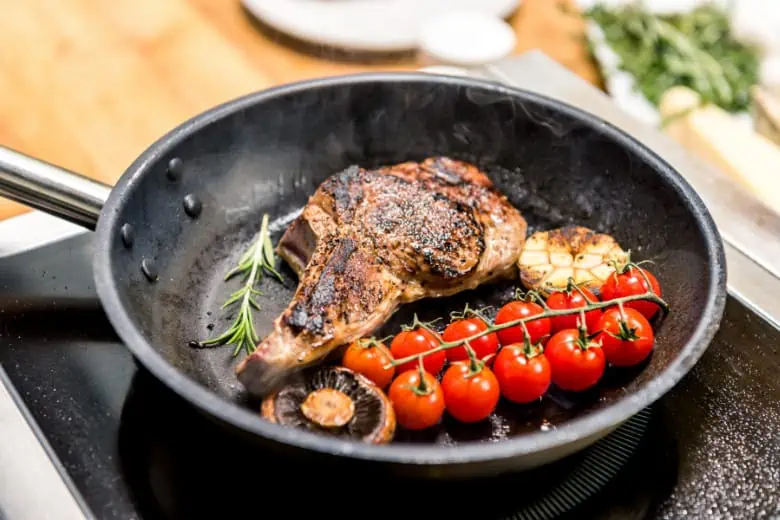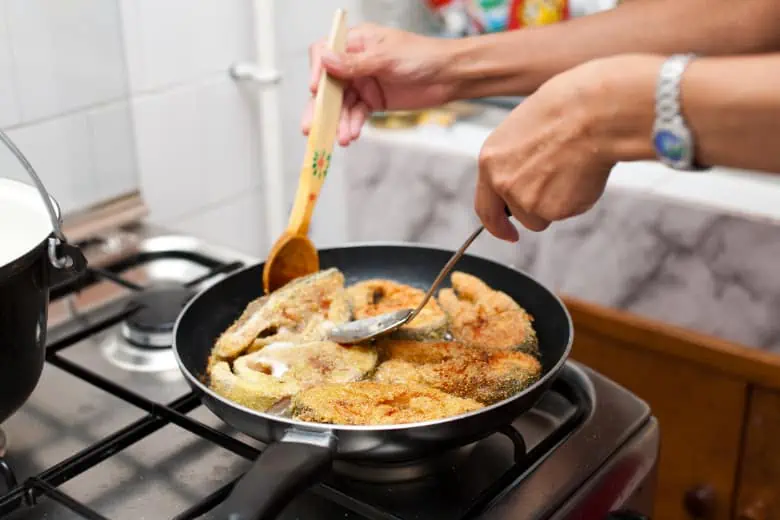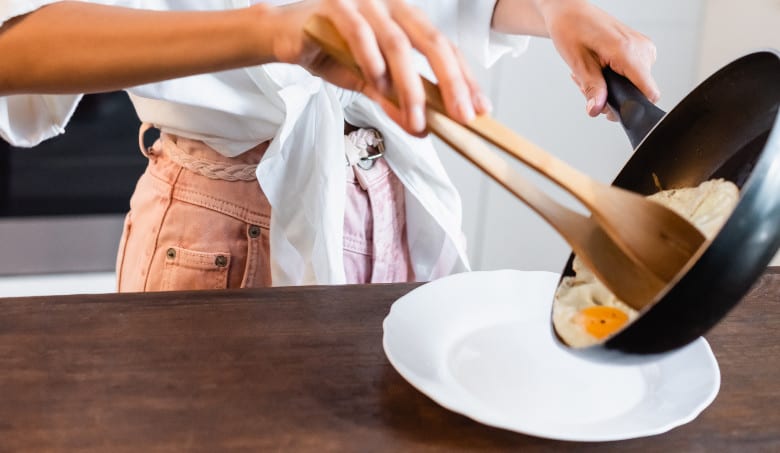The options in the cookware market are endless, but the most popular, by far, is nonstick cookware. Two popular choices are ceramic and hard anodized surfaces. Both come with their own strengths and weaknesses, making it critical for consumers to determine which will best suit their needs.
Ceramic-coated cookware offers excellent non-stick properties, allowing food to be cooked with little to no oil. Additionally, ceramic products are often considered eco-friendly because they are made from natural materials and have low heat conductivity. Similarly, hard anodized cookware comes with a non-stick layer but with the added advantage of aluminum’s even heat distribution. This hard anodizing process makes the aluminum surface harder and more durable, increasing the longevity of the pan.
When choosing between ceramic vs hard anodized cookware, it’s crucial to consider factors such as the type of coating, its durability, heat distribution, and potential toxicity. The right cookware should cater to personal cooking preferences and provide longevity to ensure it’s a worthwhile investment. In the following sections, I delve deeper into the key differences between ceramic and hard anodized cookware, equipping you with the knowledge needed to make an informed purchase.
My personal favorite was the GreenPan Valencia Pro Set. Great performance, a size for every use, is induction compatible, and at a great price.

Ceramic Vs Hard Anodized Cookware
Let’s take a look at some of the best ceramic and hard anodized cookware products to help you make the right choice for your kitchen needs.
GreenPan Lima 12-Inch Frying Pan Skillet
This GreenPan Lima 12-Inch Skillet is a versatile addition to your kitchen, offering a health-conscious nonstick surface and sturdy construction.
I recently used the GreenPan Lima 12-Inch skillet and found it to be a great kitchen companion, easily handling a variety of cooking tasks. From searing to frying, this pan offered consistent heat distribution, a comfortable grip, and the reassurance of a non-toxic ceramic coating. The beautiful design of the contoured stainless steel handle provided comfort even after prolonged use. At 12 inches, it’s perfect for large families or batch cooking. If omelets are more your speed, you might be interested in its smaller cousin, the 8-inch version.
One potential downside is that the GreenPan Lima is not compatible with induction stovetops, so those looking to utilize induction cooking won’t be able to take full advantage of this pan.
However, GreenPan has crafted an excellent high-performance frying pan that is both safe for your family and good for the environment, thanks to its environmentally friendly materials. With proper maintenance, the non-stick surface will keep you enjoying fuss-free cooking for a long time. Overall, I highly recommend the GreenPan Lima 12-Inch Frying Pan Skillet for anyone seeking a versatile and eco-conscious addition to their cookware collection.
Pros
Cons
T-fal Ceramic Excellence Reserve Nonstick 12-Inch Fry Pan
The T-fal Ceramic Excellence Reserve Nonstick Fry Pan is a must-have addition to any cookware collection, offering durability, eco-friendliness, and exceptional non-stick performance.
I recently tried the T-fal Ceramic Excellence Reserve Nonstick Fry Pan and have been impressed by its performance. T-fal’s Inoceram Glide Technology is “marketing speak” for their proprietary coating, which provides an ultra-smooth surface. I tested it while cooking some delicate trout, and it performed beautifully.
Being environmentally conscious, I appreciate that T-fal uses 100% recycled aluminum to create this pan which makes me feel good about my purchase. Their unique Thermo-Spot Technology comes in handy, as it turns solid red to indicate when the pan is properly preheated, ensuring the dish is cooked evenly.
One downside of the T-fal pan is that, like all non-sticks, it isn’t dishwasher safe, requiring me to hand wash it. But considering the ease of cleaning, this hasn’t been a significant inconvenience. Additionally, the pan is quite heavy, so people with limited strength or mobility might find it challenging to handle. Lastly, it doesn’t come with a lid, so you may need to purchase one separately if you prefer cooking with a cover.
In conclusion, the T-fal Ceramic Excellence Reserve Nonstick Fry Pan has been a joy to use, offering optimal non-stick performance, eco-friendly materials, and an attractive design. Despite its minor drawbacks, I highly recommend it to anyone who loves cooking and values sustainable products.
Pros
Cons
OXO Professional Hard Anodized Saucepan Set
After using the OXO Professional Hard Anodized Saucepan Set, I found the performance quite impressive. The ceramic non-stick coating reinforced with diamonds ensures that food does not stick to the surface while cooking. I’m not convinced that the diamonds are more than just hype, but I enjoyed using the pans.
The set comes with two saucepans: a 1.7 qt and 2.3 qt, both featuring glass lids that allow you to monitor your food without losing heat. Made of heavy-duty, hard-anodized aluminum, these pans heat up quickly and evenly, ensuring that your food is cooked to perfection. The streamlined rivets also help in maintaining a snag-free interior, as they eliminate food traps that could potentially harbor bacteria.
One thing I noticed while using these saucepans on an induction stovetop is that they took a bit longer to heat up compared to my stainless steel All-Clad pans. It wasn’t a significant issue, but it may affect the overall cooking time for some quick tasks. Another minor concern I had was the metal knob on the lid getting hot during stovetop cooking – be sure to use a potholder or a silicone cover for safety.
The OXO Professional Hard Anodized Saucepan Set offers excellent performance in terms of its non-stick capabilities and even heating, making it a great addition to any kitchen. However, be cautious when using it on an induction stovetop, and always use a potholder or silicone cover for the lid’s metal knob. Despite its higher price point, I believe this saucepan set is a solid investment for those who value quality cookware.
Pros
Cons
GreenPan Valencia Pro Ceramic Nonstick Skillet Set
The GreenPan Valencia Pro is a worthwhile investment for those looking for durable and healthy ceramic nonstick cookware.
I recently got my hands on the GreenPan Valencia Pro ceramic nonstick skillet set, and I am genuinely impressed with its performance. The non-toxic ceramic coating infused with diamonds (again with the diamonds!) not only offers easy food release and cleanup but also ensures that I’m not exposed to any dangerous fumes. GreenPan claims the Thermolon Minerals Pro coating is metal utensil safe (don’t believe it) and remarkably long-lasting, making it a pleasure to cook with these skillets. To be safe, I would still stick to silicone or wood utensils.
As someone who often uses an induction stovetop, the Magneto Induction Base in the Valencia Pro skillets is a game-changer. It provides even heat distribution, allowing me to achieve perfect searing and browning without any energy or heat loss. The strengthened hard anodized aluminum body ensures that the skillets are resistant to warping, wobbling, and scratching, adding to their durability.
However, as much as I love these skillets, there are a few considerations to keep in mind. I learned quickly that I needed to be gentle when handling the pans to protect the coating from chipping. Additionally, it’s crucial to use low heat settings when cooking, as the pans retain heat exceptionally well. Lastly, while I didn’t use the pan long enough to experience it, some users have reported a loss in nonstick properties with heavy use over time.
Finally, if you’re in the market for a skillet set that prioritizes health, performance, and durability, the GreenPan Valencia Pro ceramic nonstick skillet set is an excellent choice. Be prepared to make a few adjustments to your cooking habits, and you’ll enjoy the many benefits of these skillets for years to come.
Pros
Cons
T-fal Ultimate Hard Anodized Nonstick Cookware Set
I highly recommend this T-fal cookware set for anyone looking to outfit their kitchen with a complete set of durable, nonstick, and easy-to-use pots and pans.
As an avid home cook, I found T-fal’s Ultimate Hard Anodized Nonstick Cookware Set to be incredibly versatile. The hard anodized construction not only ensures durability but has impressed me with its scratch resistance; even with constant use, the surface held up well.
Like on the Reserve Pan, the Thermo-Spot indicator is a great feature. Knowing when the pans are perfectly preheated has made my cooking experience much more efficient and enjoyable. The indicator turns solid red when the pans are ready, helping me create evenly cooked dishes with flavor and moisture.
On the downside, it’s important to note that it’s not compatible with induction stovetops. Additionally, storing this 17-piece set may be challenging for those with limited kitchen storage. However, the versatility of each pot and pan can handle just about any cooking situation.
Careful handling is essential for maintaining the nonstick properties of this T-fal set. Although it’s dishwasher-safe, I found that gentle handwashing helps to prolong the life of the nonstick coating and is highly recommended.
Despite a few minor drawbacks, the T-fal Ultimate Hard Anodized Nonstick Cookware Set is a great starter set for new chefs.
Set includes:
- 1 qt, 2 qt, and 3 qt saucepans w/ lids
- 8-inch and 10-inch fry pans
- 11.5-inch fry pan w/ lid
- 10.25-inch griddle
- 3.5 qt saute pan w/ lid
- 5 qt Dutch oven w/ lid
- 3 qt steamer insert
- One egg wonder fry pan
Pros
Cons
GreenPan Chatham Black Prime Midnight Nonstick 8-Inch and 10-Inch Frying Pan Set
In my experience, the GreenPan Chatham Black Prime Midnight set is another solid choice. Made from durable hard anodized aluminum, the pans proved to be impressively scratch-resistant even after frequent use. No matter what I cooked, the Thermolon healthy ceramic nonstick coating made it a breeze without releasing toxic fumes, even when accidentally overheated.
One of my favorite features of these pans is their ergonomic, riveted matte stainless steel handles, which I found very comfortable and secure. However, if you’re working with induction stovetops, this set is a dealbreaker.
The 8-inch and 10-inch frying pans worked well for most of my cooking needs but maybe a bit small for those who often cook larger amounts. For that, you can try the 10-inch and 12-inch set. Additionally, I did find that these pans required a slightly longer preheating time when used on low heat. Despite these minor drawbacks, the GreenPan Chatham set truly excels in providing an enjoyable cooking experience without compromising on safety and durability.
Pros
Cons
Related: Our Cookware Buying Guide. How To Find Your Perfect Set.
Buying Guide
When it comes to choosing between ceramic and hard anodized cookware, there are several factors to consider to find the best product for your needs. In this guide, I will discuss some important features to look for in both types of cookware.
Heat Conductivity
Firstly, consider the heat conductivity of the cookware. Ceramic cookware is known for its excellent heat distribution, which allows for even cooking. On the other hand, hard anodized cookware also provides good heat distribution but may take slightly longer to heat up. Both options are suitable for various cooking methods, so your choice will ultimately boil down to personal preferences. It really comes down to the material of the pan and the thickness of the base.
Durability
Durability is another important aspect to consider. Hard anodized cookware is known for its long-lasting and scratch-resistant surface, making it a great choice for those seeking durability. Ceramic cookware, while also durable, may be more prone to chipping or cracking if it experiences sudden temperature changes or high heat levels.

Coating
Another factor to consider is non-stick capability. Ceramic cookware is naturally non-stick due to its smooth surface, while hard anodized cookware typically has an additional non-stick layer of PTFE (Teflon). Older versions of Teflon contained harmful chemicals such as PFOA. Although manufacturers now claim to produce cookware free from these toxic chemicals, which, according to the EPA, could lead to various health concerns ranging from cancer to ulcerative colitis.
If you strive for better food release and less grease, both options will serve you well. Make sure to check the manufacturer’s recommendations for using cooking utensils that won’t damage the non-stick surface. Again, silicone and wood utensils are recommended.
Maintenance
Lastly, consider maintenance and care. Both ceramic and hard anodized cookware require gentle cleaning techniques and avoiding abrasive cleaning tools to preserve their non-stick surfaces. While both types can be cleaned by hand, hard anodized cookware typically requires a bit more effort since food can sometimes stick to its surface. I always recommend keeping all non-stick pots and pans away from the dishwasher.
By considering these factors, you’ll be able to make an informed decision when choosing between ceramic and hard anodized cookware. Remember that each type has its own benefits and drawbacks, so take the time to assess your cooking habits and preferences before making a decision.
Frequently Asked Questions
What are the differences in durability between ceramic and hard anodized cookware?
In my experience, hard anodized cookware is more durable than ceramic cookware. Hard anodized aluminum is made using a process that creates a hard, non-stick surface resistant to scratches and heavy use. Ceramic cookware, on the other hand, is more susceptible to wear and tear over time, especially if handled roughly or exposed to high heat regularly.
Which type of cookware is easier to maintain: ceramic or hard anodized?
I find hard anodized cookware to be easier to maintain. As mentioned earlier, its non-stick surface makes it resistant to scratches and easier to clean. Ceramic cookware requires more careful handling and cleaning techniques to avoid damaging its surface.
How do cooking performances differ between ceramic and hard anodized cookware?
Cooking performance varies between ceramic and hard anodized cookware. Ceramic cookware heats up quickly and evenly but doesn’t retain heat, as well as hard anodized aluminum. Hard anodized cookware heats evenly and holds its temperature better, which is essential for consistent cooking results.

Is there a cost difference between ceramic and hard anodized cookware?
There may be a cost difference between ceramic and hard anodized cookware. Generally, high-quality ceramic cookware tends to be more expensive than hard anodized cookware. However, you can find affordable options in both types if you look for more budget-friendly brands. Brand names will always have a substantial effect on price.
What are the health considerations when using ceramic and hard anodized cookware?
When considering health aspects, both ceramic and hard anodized cookware have their merits. Ceramic cookware is made from natural materials and does not release any harmful substances during cooking. Hard anodized cookware, on the other hand, has an extremely durable non-stick surface that reduces the need for unhealthy oils or fats during cooking. Both types are generally considered safe for cooking as long as they’re used and maintained correctly.
Which type of cookware heats up more evenly: ceramic or hard anodized?
In my experience, both ceramic and hard anodized cookware provides even heating, but hard anodized aluminum tends to hold its temperature better and distribute heat more evenly across the surface, leading to more consistent cooking results.
Conclusion
I found that both ceramic and hard-anodized cookware have their unique advantages and disadvantages. Ceramic cookware is an eco-friendly choice, as it is made of natural materials and does not contain any harmful chemicals. It is also known for its non-stick properties and ease of cleaning. On the other hand, hard-anodized cookware is praised for its durability and resistance to wear, scratch, and corrosion.
In terms of safety, both types of cookware are considered safe options. However, ceramic cookware can break or chip if it is dropped or used improperly. Hard-anodized cookware, on the other hand, is relatively sturdy and less prone to damage.
When considering the cooking performance, hard-anodized cookware has the edge over ceramic cookware, as it heats up quickly and evenly. This is crucial for achieving consistent results in different recipes. Ceramic cookware works best for slow cooking and simmering, as it is a good heat conductor and retains heat well.
In conclusion, the choice between ceramic and hard-anodized cookware ultimately comes down to personal preferences, needs, and priorities. If eco-friendliness and non-stick properties are important factors for you, ceramic cookware may be a better choice. On the other hand, if durability and heat distribution are more critical, then hard-anodized cookware may be the right choice for you.
I highly recommend you check out the GreenPan Valencia Pro Set.






